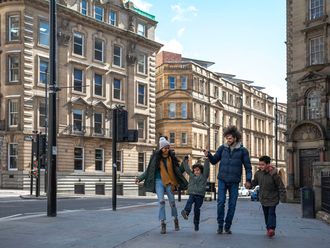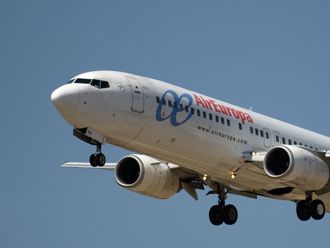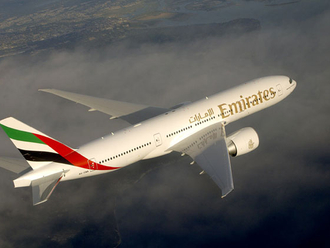
Standing at the base of Ras Al Khaimah’s highest point, Jebel Jais, I squint in the glare of the morning sun at the mountain that soars 1,934m – around two and a half times taller than the Burj Khalifa.
Making the final adjustments to my kit – a hard helmet, climbing boots, ropes and clips – and after a safety briefing from guide Fahed Zarifa, I get ready to make my way 120m up to the first level; if I am successful, I’ll be a record holder of sorts – the first person in the region to test out the emirate’s newly opened Via Ferrata, Italian for Iron Road, a first in the Middle East.
The 470m-long Via Ferrata in Ras Al Khaimah is a unique addition to the region’s adventure sports and includes a bit of trekking and mountain climbing, three individual start and finish points, and three zip-lines, measuring 50m, 60m and the last a stomach-churning 300m.
I’m part of a group of four adventure enthusiasts, plus four guides, and we set off on a trek on the first of the three courses. Clambering over small boulders and rocks, the first course, Ledge Walk, is a moderate climb. Safety lines with anchors drilled deep into the limestone rockface have been laid throughout the course, and every two to three metres we need to unclip and re-clip ourselves to the line ensuring that we are connected to the safety cables at all times while on the move.
Behind me is guide Andy Shipman, an ex-RAF man who’s walked the route several times while setting up the safety wires. Part of a team that has worked on peaks all over the world, from Europe to Asia, Andy is a master of the mountains.
The first section of the course is admittedly slow as we are all coming to grips with the terrain and the procedure of unclipping from and reconnecting to the cables. But after a few times, I get used to the process and 40 minutes later am proudly panting at the first short zip point preparing for the second part of the trek. ‘You need to keep sipping water,’ Andy advises. I obey and also snack on the energy bars I stashed in my back pack.
Although I’m all for a bit of competition, standing at the brink of the table – the take-off point for the zip line – this time I very graciously offer one of my pals the opportunity to go first. The strong steel cable is tethered ‘very safely into the rocks’, says Andy, and stretches 50m to the next mountain. But looking down, I see the rest of the support team far below, some 80m down on the road, and that makes my heart skip a couple of beats.
I breathe in deeply trying to calm my nerves. ‘The wires are tested and are safe,’ I tell myself. ‘There’s nothing to worry about.’
Andy, perhaps guessing what is running through my mind, reminds me that the only alternative in case I chicken out is to be airlifted, which at stage one of the course isn’t really an option.
‘You can do it,’ he encourages me.
I try to convince myself that I can, although the only thought that keeps ringing through my mind is, ‘Am I really going to whizz across a mountain tethered to a thin steel cable bolted to a rock?’
Ahead of me, two guides seem to make it look so easy.
‘Mark, you’re next,’ says Andy, giving me some last-minute instructions on how to land safely on the other side.
Mark Setchfield tries out the Via Ferrata and the UAE’s longest zip line in Ras Al Khaimah:
Very slowly I move closer to the edge. The zip line, harness and clips are checked. My guide gives me the thumbs up. Gripping the harness, I push myself off the rocks secured to the 50m cable, and sail off across the mountain. In barely a few seconds – 10 seconds actually – I’m at the other end pulling myself up and on to the landing mat. It seems to have happened in the blink of an eye and I realise I forgot to look down and admire the view as I raced across the line.
My feet still trembling, I unclasp myself from the zip line, and move away to make way for the rest of the team to land.
Adrenaline still racing through my body, I feel a bit wobbly as I take in the scenic beauty of the view from the mountain. A few rocks slip off the mountainside and bounce off boulders on their way down. In the morning stillness, the sound of rock hitting rock echoes across the valley. It’s at that moment that I get a real sense of just how high I am. ‘In building terms you are now roughly on the 20th floor,’ says Andy.
This is stage one. We will be climbing again to the second zip line and with sweat dripping, I stop to view the fabulous vista of the mountains. Though I’ve gone skiing several times in Europe, I realise the physical challenges of climbing a rocky mountainside are entirely different and truly exhilarating.
Having one zip line under my belt, I’m a tad more confident and so quickly begin my ascent to stage two.
In 35 minutes I am ready for the second zip line – this one is 60m across.
‘We are roughly about 30 stories high,’ Andy tells us. I look down to see a small crowd of passers-by who have stopped on the road, and are waving out to us mountain adventurers and taking pictures.
Fahed attaches me once again to the zip line, checks and rechecks the harness and clips, before smiling and giving me the thumbs up.
Perched on the edge of the rock I take a deep breath, grip my harness and launch myself off. The sense of exhilaration is immense and I actually remember to look down and see the mountainside whizzing past me. This time, the landing isn’t as smooth as the first. I reach up to grab the cable and almost miss it before the helpful guide grabs me and drags me up to the small shelf of rock, instantly hooking me to the safety wire. If my heartbeat is any indication, this is a lot more challenging than the first zip line.
I take a couple of sips of water from my bottle and pause to enjoy the view and snap a few pictures.
My watch indicates that we have been on the mountain for over two hours of the four-hour trek. Now it’s time for our final ascent to the last zip line. This is by far the most challenging section – the rock face is steeper, the trail narrower, the rocks sharper and looser and my muscles tauter.
The change in the mood of the group is palpable. We are being pushed to our limits and there is little or no conversation amongst us. ‘Focus, guys,’ shouts out Andy. ‘Watch your step and push on.’
I stop to catch my breath and take in the views to appreciate how high and steep the mountain is.
‘We are about 40 stories high now,’ he says. That’s as high as my building in Jumeirah Lake Towers, I think to myself. Taking another swig of water, I follow the group to the third and final zip.
This one is a 300m zip line and watching the team members sailing across the wire triggers butterflies in my stomach. Although I’ve notched up two zip lines and am looking forward to this last one, I’m also exhausted. As much as I want to experience another rush of adventure, I’m also keen to get down to base camp and stretch my legs.
Poised on the edge of the platform, Andy checks and rechecks my harness and clips one last time.
‘You’re ready, mate,’ he says.
My heart is racing now as I look down. Far below I see small stick figures presumably looking up at us. I close my eyes for a moment, count down from three, then push myself off.
Zipping across at around 45kph, I suddenly begin to spin a bit when I reach the midpoint – then I’m racing to the landing platform. A guide is there to grab me and hoist me on to the rocks where he secures me to the harness. I heave a sigh of relief.
High-fiving the group, we head back down to base camp.
As we pose for pictures, the sense of euphoria begins to sink in. Now I know how Edmund Hillary felt when he stood atop Mount Everest. I had pushed myself to the limit, hauled myself up steep and challenging rocks, dangled myself on a thin cable, flown through the air at 40kph...
‘Would you do it again?’ asks Andy.
‘Absolutely,’ I say.
‘Plans for the Middle East’s longest zip wire in the world are in progress,’ he says. ‘It will beat Toro Verde Adventure Park in Orocovis, Puerto Rico, at 2.313km long.’
Until that is ready, I’ll be visiting Ras Al Khaimah more often over the winter months.
WANT TO TRY IT YOURSELF?
- All visitors will need to prove themselves on the standard course before being allowed on one of the more technical routes.
- Minimum age and weight restrictions apply for adventurers, who must be at least 12 years old and weigh at least 41kg and no more than 95kg.
- You can choose from the three routes on twice-daily supervised tours starting at 8am and 1pm.
- Tourist groups get free transfers to and from Manar Mall, Ras Al Khaimah.
- It’s Dh400 per person.
- Book at jebeljais.ae











